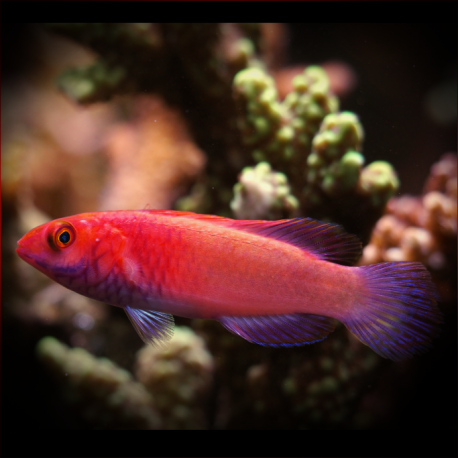More info
Datasheet
| Minimum Tank Size | 400 litres / 105.67 US gallons |
| Maximum Size | 7.0cm / 2.76inches |
| Reef Compatible | Always reef safe |
| Temperament | Might be aggressive towards food competitors |
| Temperature | 22.2°C / 71.96°F - 25.6°C / 78.08°F |
| Specific Gravity | 1.020-1.025 |
| Carbonate Hardness | 8-12 |
| pH | 8.1-8.4 |
General Description
The Red Velvet Wrasse, scientifically known as Cirrhilabrus rubrisquamis, belongs to the Labridae family, specifically the Cirrhilabrus genus. These fish are renowned for their stunning and vibrant colors, making them a visually striking addition to aquariums. They exhibit varying degrees of boldness, with some acclimating quickly to their environment while others require a more peaceful introduction. Red Velvet Wrasses are known to change gender, transitioning between male and female, and males can display flashy colors during courtship.
Aquarium Suitability
Red Velvet Wrasses are generally suitable for most aquarium setups, given that they are provided with adequate space and hiding spots. They are best kept in pairs, with one male and one female, or in a larger group with one male and multiple females. These fish can be aggressive towards similar species or if they feel confined, necessitating a spacious tank of at least 400 liters but preferably 800 liters or more. Additionally, a secure lid is essential as they have a tendency to leap out of open aquariums.
Demands, Care, and Hardiness
This species has an average level of hardiness and is sensitive during transportation and acclimatization. Red Velvet Wrasses are docile and shy, requiring cautious consideration when housed with more aggressive tank mates. They need frequent feeding, several times a day, particularly when first introduced to the aquarium. To maintain their vibrant colors, a varied and high-quality diet rich in pigments is essential. These wrasses can lose color in captivity but proper nutrition and ample swimming space can help mitigate this issue.
Reef Suitability
Red Velvet Wrasses are considered reef-safe and can coexist harmoniously in reef aquariums. They contribute to the ecosystem by preying on unwanted invertebrates such as flatworms and pyramid snails. However, it is crucial to understand the individual species' behaviors and requirements before incorporating them into a reef setup.
Aquarium Setup
To create an ideal environment for Red Velvet Wrasses, a well-established aquarium with live rocks for hiding places is recommended. Maintaining water parameters within the range of pH 8.1-8.4, dKH 8-12, salinity 1.020-1.025, and temperature between 22.2-25.6°C is crucial for their well-being. Provision of ample swimming space and a secure lid to prevent jumping are essential considerations when setting up the tank for these colorful wrasses.
Behaviour
Red Velvet Wrasses exhibit varying behaviors, from peaceful to potentially aggressive towards food competitors. They thrive in environments with plenty of open swimming space and may form hierarchical structures within the group. Males can engage in light aggression with each other, emphasizing the importance of introducing them simultaneously or females first to create a harmonious dynamic.
Feeding and Diet
In the wild, Red Velvet Wrasses feed on a diet ranging from zooplankton to large crustaceans. In captivity, they should be offered a diverse diet of small crustaceans like krill and artemia, as well as zooplankton such as cyclops and pods. Regular feeding, at least twice a day, is necessary to maintain their health and vibrancy.
Dimorphism and Captive Reproduction
Male and female Red Velvet Wrasses can exhibit significant differences in coloration, with males often displaying more vibrant hues. These fish have the ability to change gender from male to female and vice versa, a unique trait seen in certain wrasse species. Captive reproduction may be possible under optimal conditions, with successful breeding contributing to the sustainability of these captivating marine fish.
Habitat and Distribution
The Red Velvet Wrasse is native to the Western Indian Ocean, specifically found in regions such as the Maldives and Chagos Archipelago. These fish inhabit coral reefs and prefer areas with ample hiding spots among rocks and crevices. Understanding their natural habitat and distribution can aid in replicating suitable conditions within the aquarium for their overall well-being.
Cautionary Note: Always exercise caution when handling or keeping Red Velvet Wrasses, as their sensitive nature and specific requirements contribute to their overall health and longevity in an aquarium setting.

